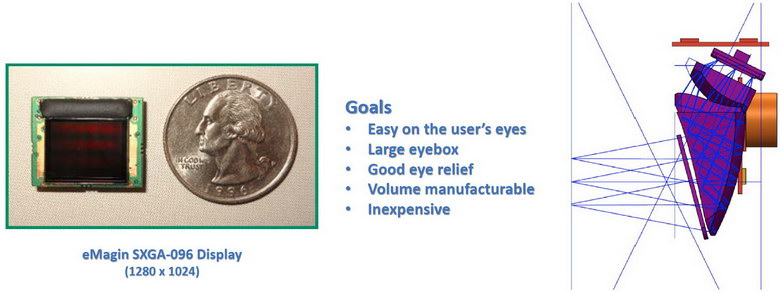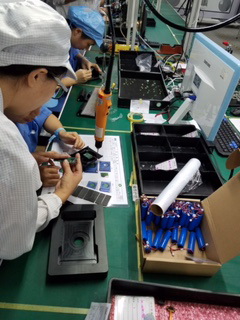Dan Cui, Chief Marketing Officer for eMagin’s HMD Division, recently gave a talk to the SID Mid-Atlantic Chapter (SID-MAC) on his division. Dan has been working in the HMD/VR/AR business since 1997 when he was at Myvu/ViewLink, one of the early Head Mounted Display (HMD) market leaders and developer of the first Android smart glasses. The Myvu patents eventually led to the development of Google Glass. He left Vuzix to join eMagin in April, 2015.
Since then, the eMagin HMD division has developed two closely related products, the Blaze Torch and Blaze Spark night vision systems. These systems use the same night-vision camera but the Blaze Torch is a head-mounted display (HMD) that is based on a pair of eMagin SXGA (1280 x 1024) monochrome OLED microdisplays while the Blaze Spark is a hand-held bring-your-own-display (BYOD) unit that is based on a smartphone.
 Meko’s Matt Brennesholtz tests eMagin’s Blaze Torch night-vision goggles. The circle is the camera lens and the IR illuminator is just above it. (Photo: M. Brennesholtz)
Meko’s Matt Brennesholtz tests eMagin’s Blaze Torch night-vision goggles. The circle is the camera lens and the IR illuminator is just above it. (Photo: M. Brennesholtz)
The night-vision camera is assembled by eMagin, and is not a purchased component. Cui told me this is done because eMagin wants to keep control over the entire design. The camera is not just low-light, it covers an expanded spectral range from about 400nM to about 1200nM. Visible light is normally considered to cover the spectral range of about 400 – 780nM. The camera sensor also covers the near-IR range of about 780 – 1200nm. The 720p (1280 x 720) HD sensor is mated to a standard f/1.4 fixed-focus IR corrected, wide angle lens. The camera produces usable images in very low light levels, down to 0.001 Lux. Cui declined to tell me who supplies the imager or the camera lens.
 eMagin’s Blaze Torch. Left: Night-vision device flipped down for use. Center: Night-vision system flipped up for normal vision. Right: Images on the dual OLED microdisplays. The helmet worn by the skier is not part of the HMD system. (Images: eMagin)
eMagin’s Blaze Torch. Left: Night-vision device flipped down for use. Center: Night-vision system flipped up for normal vision. Right: Images on the dual OLED microdisplays. The helmet worn by the skier is not part of the HMD system. (Images: eMagin)
The Blaze Torch uses the camera in a night vision module that is attached to a pair of goggles and will flip up out of the way to allow normal vision. Rather than design their own goggles, eMagin partnered with Revision Military out of Burlington, VT to have their Desert Locus Goggle System modified for this eMagin application. The goggles meet professional eye safety requirements. The three hour Lithium Ion battery is attached to the back of the goggle head band and is connected to the HMD via an external cable. Cui said the next revision of the unit will put the cable in the headband itself.
Blaze Torch has a built-in IR LED illuminator at either 850 or 950nM for times when the natural light is below the usable light of the night-vision camera. It can also provide “fill light” for back-lit subjects. I found this fill light capability useful when using the unit at SID-MAC. It made it easier to identify faces even though the ambient light was well above the Torch’s minimum level. The Torch will record HD video and audio on a SD card up to 128G. Blaze Torch will not live-stream the output of the night-vision camera -you must download it to a computer, tablet or smartphone for editing or uploading to the Internet.
 Optical design of the image modules of the Blaze Torch. (Image: eMagin)
Optical design of the image modules of the Blaze Torch. (Image: eMagin)
The near-the-eye (NTE) optics in the Blaze Torch are all plastic and provide an eyebox large enough that interpupillary distance adjustment is not necessary. The eyebox can accommodate interpupillary (IP) distances from children through adults. When asked if they had considered using only a single eMagin display and splitting the image, Cui replied “we’ve done this in the past, but [we had] a lot of alignment issues. Also working with two displays provides a path for stereoscopic vision when we’re ready.” Stereoscopic vision, of course, would require the addition of a second night vision camera, separated from the first by the normal IP distance.
Since the image goes directly from the camera to the eMagin OLED display, without processing through a smartphone, there is very little latency in the system, about 0.5mS according to Cui. This allows the Blaze Torch to be used for activities including night skiing or mountain biking that require real-time responses.
 eMagin’s Blaze Spark. Left: System with smartphone. The night vision camera is in the center and the smartphone camera can use the window in the system on the right. Center: Inserting the smartphone. Right: Nightvision image on the smartphone screen. (Images: eMagin)
eMagin’s Blaze Spark. Left: System with smartphone. The night vision camera is in the center and the smartphone camera can use the window in the system on the right. Center: Inserting the smartphone. Right: Nightvision image on the smartphone screen. (Images: eMagin)
Blaze Spark uses the same night-vision camera but uses the smartphone display to show the images instead of the eMagin OLED microdisplays. Currently, Blaze Spark is only for Android smartphones with a micro-USB connector. When asked about an iOS version, Cui said, “we will have an engineering unit this month and [then] have to get Apple approval before talking about release of an Apple product.” A downloadable app for the Blaze Spark allows live streaming of the video from either the night vision camera or the normal camera built into the smartphone.
The three hour Lithium-ion battery is built into the Spark system, and is not external like the Torch. Like the Torch, the Spark also includes an IR illuminator for when the ambient light isn’t adequate for the low-light camera. While the Spark is not suited for real-time applications like skiing, Cui says it has attracted a lot of interest among people that can tolerate a few frames of delay, like hunters and people trying to dock a boat at night.
 eMagin’s Blaze Spark being assembled by the contract manufacturer in Shenzhen. Cui declined to identify the manufacturing partner. (Image: eMagin)
eMagin’s Blaze Spark being assembled by the contract manufacturer in Shenzhen. Cui declined to identify the manufacturing partner. (Image: eMagin)
In his talk for SID-MAC, Cui made several points about HMDs in general. Key points about the market include:
- Technology does not sell products
- Design for the social experience
- There must be an ecosystem
Blaze Torch and Blaze Spark were designed to fill needs that consumers could see for themselves with minimal education and no need for a content-creation ecosystem. He said that the design-to-production time for these systems was very fast, only about one year. One of the goals of the product design was to give eMagin, whose main customers are military, a foothold for its products in the consumer market. Another goal was to produce a positive cash flow for the company.
Blaze Torch and Blaze Spark are both shipping now from the eMagin on-line store. The Torch is priced at $999 and the Spark is priced at $299. For the time being, Cui said the company will not pursue other retail outlets such as ‘big-box’ stores. –Matthew Brennesholtz

